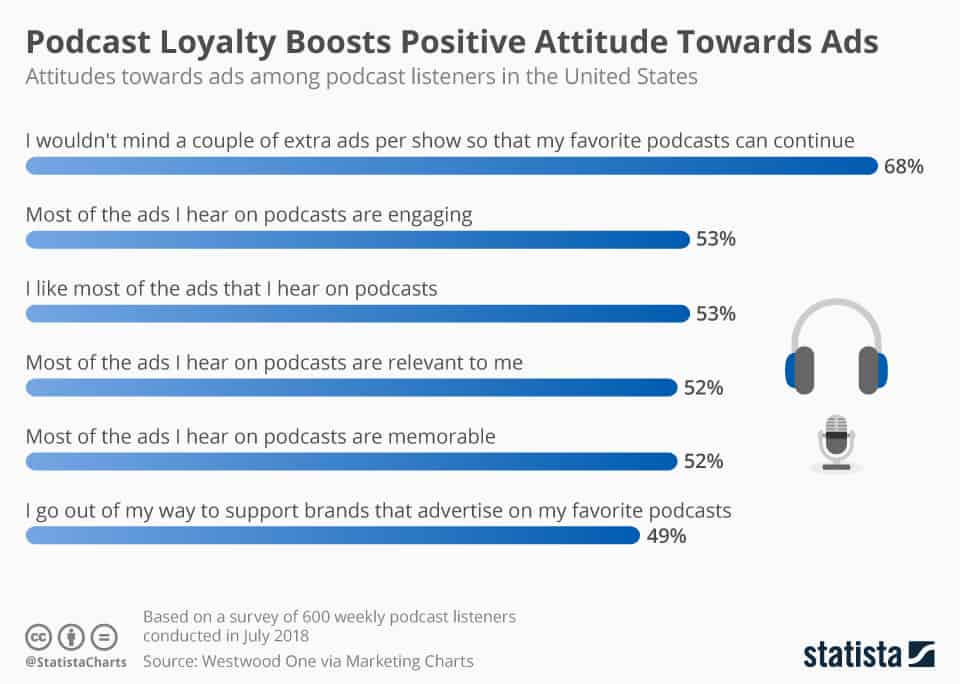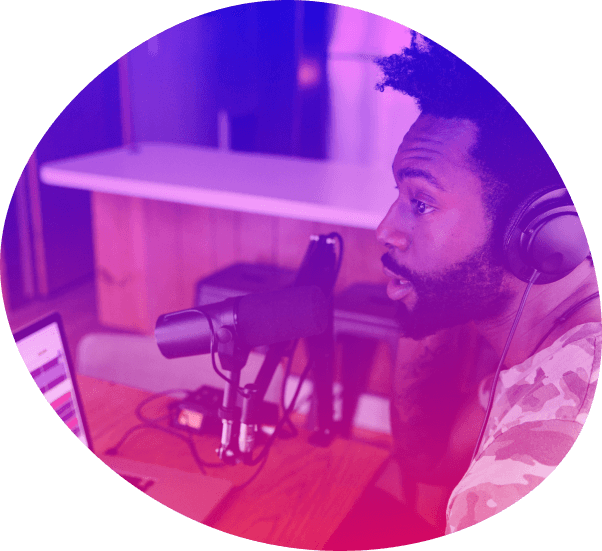If you’re making a podcast, there’s a good chance you’re creating other types of content as well. You can be blogging, sending email newsletters, posting on social media, vlogging, or doing something special.
Connecting all your content channels together can be a challenge. If you do it right, you can create a perfect experience for your audience that adds a lot of value to their lives.
In this article, we help you organize your podcast content to fit all of your content.
Practice
Read how to start your own podcast? Learn the nitty-gritty details of starting your own show in our complete guide. Learn more about starting a new podcast.
Podcasts are like your content hub
We may be biased, but we believe that podcasting should be a core part of your content production. It should be a content channel that leads other content channels. All of your content should come from podcasts.
Think of your podcast as the hub of a wheel. The other content you create – like blog posts like blog posts, social media, email newsletters, live streams, etc. – are the spokes of the wheel. This makes your podcast program the foundation of everything else you do.
There are four main reasons why podcasts deserve center stage here:
1. Podcasts create more engaged audiences than other types of content
Although it is possible to build a loyal audience with your articles or social media, it is more difficult because there is no direct human connection. The average weekly listener spends 6 hours and 39 minutes listening each week.
What is the reason for this deep connection? You human voice. It is easy for the audience to forget that you are a business and a brand. They become fans of you a good person who tries to collaborate with them to solve problems or bring value to their lives. In fact, podcasters are so loyal to their shows that they are more than willing to listen to ads to get the content.

2. Creating a podcast episode is faster than creating many other types of content
Once you have a podcast, it’s a quick way to create content. Once you account for setup and the inevitable mistakes, creating a 30-minute event shouldn’t take more than an hour.
You will need to spend time editing, of course, but the total time spent is still less than the time it would take to write an article, speak at a program, or design information. In fact, you can outsource your podcast editing to reduce your time expenditure.
That said, creating a program is fast once you become Good at podcasting. In the beginning, you will make many mistakes. It’s important to take the time to learn good microphone techniques, build a recording environment, and learn how to speak in a way that doesn’t require a lot of creative work.
Advice
Castos Productions is a podcast editing service made for you. Our team of talented audio engineers, skilled show writers, and producers will take care of all aspects of your podcast after you record the event. Learn more about Castos production.
3. Podcast guests make your content better
You may be an expert in your subject, but there is no doubt that there are things you don’t know, experiences you don’t have, and ideas you don’t have. This makes your content look pointless and one-dimensional, unless you add a visitor to the mix.
Great hosts offer unique perspectives and experiences that you wouldn’t normally have. Not only do they make your podcast useful, but you can use their opinions, stories and experiences in your other content. For example, if a visitor describes an interesting way he solved the problem, you can use that contribution in your other content channels (as long as you cite it correctly). This makes all your content useful.
4. Podcasting is a great place to come up with new content ideas
If you create a lot of content, you know how hard it is to come up with new ideas. You can see many things topic, but how do you know if they are worth investing in content?
The best way to get new ideas is to expose yourself to new ideas by talking to other interesting people. This means that the visitors you bring to your podcast are a great source of potential topic ideas – for podcasting or other types of content.
Also, your visitors can challenge your ideas and give new ideas. Ultimately, this makes your content better.
But you don’t have to translate these new ideas into other aspects. Guest posts can inspire tweets for your audience to follow. You can design one of their questions in your personal Facebook group. Or you can incorporate new ideas into your group process. There are many ways you can use what you learn from your program to improve your content.
Grow your audience with Castos
Castos gives you all the tools and expert guidance you’ll need to create a great podcast that will have a lasting impact on your brand.
How to incorporate podcasts into your content
Okay, so you’re ready to make your podcast part of your content. That means creating content that starts with your presentation. Let’s take a look at what that looks like for your brand.
Step 1. Plan and record your podcast presentation
Since your podcast is the center of your content, your event should come first. Record podcast episodes based on topics you think will interest your audience. Alternatively, you can choose a topic based on the visitors you have planned for the presentation. For example, if you interviewed a behavioral therapist, your event must be about behavioral therapy.
Step 2: Come up with new ideas and activities
Once your event is complete, the next step is to come up with potential ideas for other types of content. This is not something that you can do during the recording, because you often use your hands to communicate with your guest, read from your notes, and try to create a great event. So you have to listen to the episode right after it’s done or read the transcript. (There are many easy ways to create podcast transcripts.)
As you go through the activity, make a note of any words, thoughts or ideas that can generate great content. For example, let’s say you interviewed a financial advisor who talked about a special tax plan. The tax plan can form the basis for a new blog.
Keep in mind, however, that not every idea should be an article, video, or podcast episode. Sometimes, ideas from a podcast are appropriate for a tweet, a LinkedIn post, or a discussion question in your personal community.
Check out this idea from Business2Community. It is a good example of how one idea can turn into many.

Step 3: Create a content plan from your ideas
Before you dive into creating your new content, take the time to create a plan. You don’t need much, just a good idea of what the content will look like before you spend time on it. For example, if you think an idea deserves a blog post or video, use bullet points to create an outline. If you think an idea should be discussed on Twitter, think of questions to ask your followers.
Why bother? When you create a lot of content, it’s important to think at a higher level. You need to know how all the content supports itself. Ideas refer to other content pages that are more valuable than just related content.
In addition, you may start planning a content section only to find out that the process is not good. What you thoughts would make a good story that might just need a Twitter thread.
Step 4: Create an improvement plan
Your last step before creating content is to ask yourself an important question: “How can I promote it?” How you promote your content can affect its creativity.
For example, let’s say you decide to write an essay based on an idea discussed in a podcast episode. How can you improve it? Well, you can want people to find it on Google, which means you have to take search engine optimization seriously. If you decide to post a video on Instagram, you will probably create an audiogram.
Step 5: Create your new content
Once your plan is complete and you know exactly what you want to create, your next step is to actually create it. Start creating your content based on the plan you created in step three, but don’t let your podcast fall behind. You may aim to create six blog posts, but if you can only get two of them done before it’s time to work on the next event, then so be it. Remember, your podcast belongs center of your content, so it cannot be ignored.
As you create content, always refer back to your presentation. Use phrases like, “As we discussed in episode 37” or “That reminds me of my interview with John Doe.” Of course, don’t be shy about promoting either way of content you create into new content.
Try to maintain the same personality in your content as you do in your presentation. Your goal is to create the perfect experience so that your audience can develop a personal connection with you. If you like being silly in the movie, be silly in your blog, emails, and social media too.
Creating a lot of content is difficult, especially when you have a lot to say, so it’s important to create an iterative process. It’s more effective to create content regularly than to try to create too much and end up burning yourself out.
More ways to integrate podcasts into your content mix
If the “make your podcast the center of your world” approach isn’t for you, that’s okay! It’s still a useful tool to connect with people, even if you’re using it as an alternative channel.
One piece of advice we would give is to not use your podcast to reproduce other types of content. You don’t want to repeat yourself. For example, if you have a blog post titled “How to start your first Facebook ad campaign,” don’t create a podcast by the same name with the same content. Repeating yourself teaches your audience that it’s not worth checking everything you create.
The type of podcast content you create will depend on the nature of your show and your audience, but here are some ideas to get your brain thinking:
- Summary of contents. Explain what else you did.
- Behind-the-scenes information about what’s happening in your organization.
- Recordings from live events you attend.
- Company presentation. What’s going on in your space?
- Use part of your video audio for your presentation, but add commentary.
- Use parts of the story as a loose script (and feel free to roam).
As always, be sure to post other content that you create. Take every opportunity you can to direct your audience to other types of content. You can also direct your audience to share social media posts if they are popular and relevant.
Add podcasts to your content mix
Podcasting is a powerful tool to connect with your audience and build an engaged, loyal following. As podcasters ourselves, we can tell you that podcasting is a natural and satisfying way to create content, so it’s suitable for any situation and creative mix. Use the steps we’ve outlined in this article to make your podcast a seamless part of your brand platform.
Podcasting just got a lot easier
With Castos, you’re just a few clicks away from launching an impactful podcast for your brand.


0 Comments